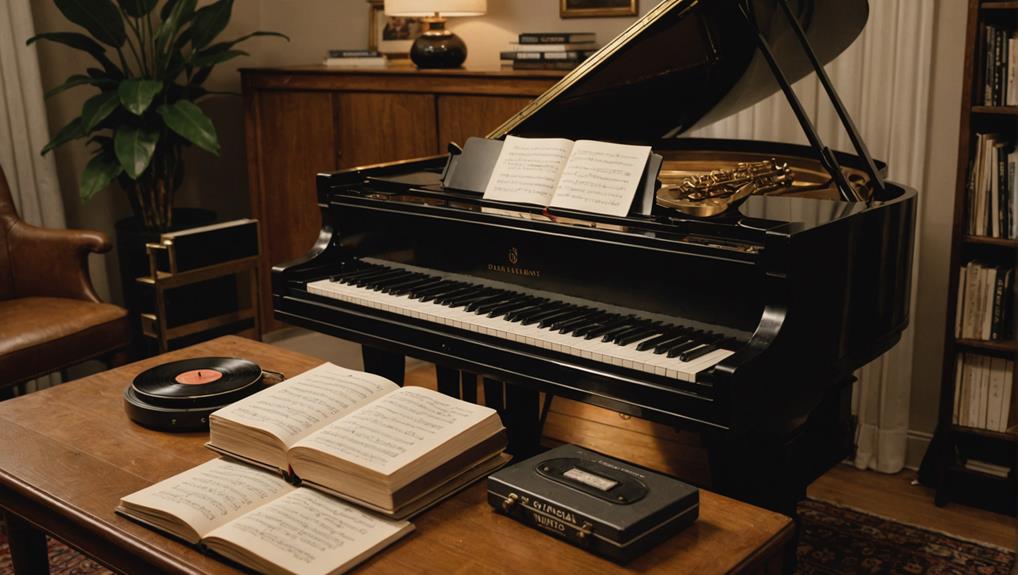Mastering the 6/8 time signature requires grasping its structure: six eighth notes per measure, grouped into two sets of triplets. Feel the pulse by recognizing the strong-weak-weak pattern and emphasizing strong beats. Count by splitting the measure into ‘1-2-3, 4-5-6’ to guarantee rhythmic precision. Focus on beaming three eighth notes together to clarify beats visually. Familiarize yourself with common rhythmic patterns like dotted quarter notes and syncopation for dynamic interpretation. Practice these techniques to enhance your fluency and precision in 6/8 time, and you’ll uncover deeper levels of rhythmic complexity and musicality.
Key Takeaways
- Count in groups of six eighth notes, emphasizing the strong beats (1 and 4) for rhythmic accuracy.
- Practice subdividing beats by counting ‘1-2-3, 4-5-6’ to maintain timing consistency.
- Recognize the strong-weak-weak pattern in each measure to feel the pulse.
- Familiarize yourself with common rhythmic patterns, such as dotted quarter notes and syncopated accents.
- Use note beaming to visually group three eighth notes, enhancing rhythmic interpretation.
Understanding 6/8 Time Signature
Understanding the 6/8 time signature starts with recognizing that it consists of six eighth notes per measure, with the top number indicating the quantity of beats and the bottom number signifying the note value that receives one beat.
This time signature’s nuances lie in the subdivision of the beats. Instead of feeling six individual beats, you typically interpret them as two sets of three eighth notes. This triplet grouping is essential for accurate musical interpretation and rhythmic precision.
When you see a 6/8 time signature, you should note how it differs from other signatures like 3/4. While both can have six eighth notes, 6/8 groups them into two larger beats, creating a distinct pulse. This grouping allows for a flowing, dance-like rhythm, often used in genres such as waltzes and marches.
In 6/8, rhythmic possibilities expand beyond eighth notes. You’ll encounter half notes, quarter notes, and beamed groups of three eighth notes, each contributing to the piece’s overall feel.
Feeling the Pulse
Grasping the pulse in a 6/8 time signature involves recognizing the inherent strong-weak-weak pattern within the triplet-based grouping of beats. This pulse recognition is essential for rhythmic accuracy and allows you to internalize the beat subdivision that defines 6/8 time.
Each measure consists of two main beats, each subdivided into three equal parts, creating a triplet feel. You’ll notice a strong emphasis on the first beat of each triplet group, followed by two weaker beats.
To master feeling the pulse in 6/8, consider:
- Internalize the Triplet Feel: Practice counting “1-2-3, 4-5-6” to emphasize the strong-weak-weak pattern.
- Tap or Clap Along: Physically tapping or clapping can help solidify the beat subdivision in your mind.
- Listen to Examples: Engage with music written in 6/8 to hear how the pulse and phrasing come together.
- Use a Metronome: Set it to highlight the main beats (e.g., 1 and 4) to reinforce the strong-weak-weak grouping.
Developing this pulse recognition enhances your ability to maintain rhythmic accuracy and interpret musical phrasing fluidly. With practice, you’ll find that your musical performance in 6/8 time becomes more cohesive and natural.
Counting in Groups
To effectively count in 6/8 time, you must understand the beat structure, emphasizing the strong beats while grouping the eighth notes.
Practicing with examples allows you to internalize the rhythmic patterns and maintain precision.
Understanding Beat Structure
Counting in 6/8 time signature requires you to group notes into sets of three eighth notes, creating a rhythmic structure that’s both vital and essential for accurate interpretation.
Each measure in 6/8 contains a total of six eighth notes, but you’ll feel the beats in two sets of three. This grouping is pivotal for maintaining beat division and ensuring proper tempo control, which are key to effective music interpretation.
Understanding this grouping can be broken down into several practical steps:
- Identify the Beat Division: Recognize the two main beats in each measure, each consisting of three eighth notes.
- Internalize the Rhythmic Structure: Practice clapping or tapping to feel the two sets of three eighth notes.
- Maintain Tempo Control: Use a metronome to keep a steady tempo, focusing on the natural flow of the two groups.
- Apply to Music Interpretation: Listen to pieces in 6/8 and notice how the rhythmic structure influences the overall feel and phrasing.
Emphasizing Strong Beats
Emphasizing the strong beats in 6/8 time signature involves accentuating the first and fourth eighth notes of each measure to create a clear and consistent rhythmic pulse. By focusing on these strong beats, you can enhance both rhythmic phrasing and performance clarity. This technique helps maintain a steady rhythmic flow, vital for accurate musical interpretation.
Counting in groups of three eighth notes is essential for understanding the structure of 6/8 time. Each measure consists of two groups of three, with the strong beats on the first and fourth notes. This approach not only improves rhythmic accuracy but also aids in interpreting the music more effectively.
Here’s a visual representation of how to count in 6/8 time, emphasizing the strong beats:
| Group | Beats |
|---|---|
| Group 1 | 1 2 3 |
| Group 2 | 4 5 6 |
| Strong | 1 4 |
| Weak | 2 3 5 6 |
Practicing With Examples
Practicing with examples in 6/8 time signature helps you internalize the rhythmic grouping and enhances your ability to maintain a steady pulse. To master this, start by counting ‘1, 2, 3, 4, 5, 6,’ which groups the notes into two sets of three eighth notes. This approach allows you to feel the rhythmic pulse accurately and navigate complex rhythmic structures more effectively.
Using musical examples is essential in this practice. Try rhythmic exercises that incorporate different rhythmic patterns within the 6/8 framework. Metronome practice is also important. Set your metronome to emphasize the first beat of each group of three eighth notes, which will reinforce your sense of timing and pulse.
Here are some practical steps to get started:
- Begin with simple exercises, like clapping or tapping the rhythm, to build a solid foundation.
- Use a metronome to keep a consistent tempo and emphasize the strong beats.
- Transition to playing simple musical examples, such as scales or arpeggios, in 6/8 time.
- Gradually incorporate more complex rhythmic patterns to challenge your timing and coordination.
Note Beaming Basics
Beaming notes in 6/8 time signature involves grouping three eighth notes together to clearly convey the music’s rhythmic structure. This beaming technique enhances rhythmic clarity by visually organizing the notes to reflect the underlying triple meter. When you group notes into sets of three, you provide a clear visual cue that helps musicians interpret and internalize the rhythm more accurately.
Vital note grouping is essential; it delineates the rhythmic subdivisions, guaranteeing each group of three eighth notes stands out. This not only aids in reading the music but also in feeling the natural flow of 6/8 time. Visual organization through proper beaming ensures that each beat in the measure is distinctly represented, clarifying the notation and reducing potential confusion.
To achieve this, you can beam eighth notes within each beat or extend beams across multiple beats if necessary to maintain clarity in complex passages. Mastering these beaming techniques is indispensable for accurately conveying the intended rhythmic structure. By understanding and applying these principles, you’ll markedly enhance your ability to perform and interpret music written in 6/8 time.
This precise approach to note beaming is foundational for any musician aiming to master this time signature.
Common Rhythmic Patterns
You’ll encounter various rhythmic patterns in 6/8, from basic groupings of three eighth notes to syncopated offbeat accents.
Pay attention to how dotted quarter notes can add complexity and flow.
Understanding these patterns is essential for accurately interpreting and performing music in 6/8 time.
Basic 6/8 Rhythms
How can you effectively count and play basic 6/8 rhythms, given their common patterns and syncopated accents?
First, understand that 6/8 time signature divides each measure into six eighth notes, typically grouped into two sets of three. This gives the music a flowing, compound feel, ideal for styles like waltzes.
To master basic 6/8 rhythms, focus on these key elements:
- Rhythmic accents: Accents often fall on the first and fourth beats. This can create syncopation, adding a dynamic contrast that enhances musical phrasing.
- Tempo variations: Adjusting the tempo affects the feel of the rhythm. Faster tempos emphasize the flowing nature, while slower tempos highlight each beat’s subdivision.
- Common patterns: A typical rhythm in 6/8 is a dotted quarter note followed by an eighth note. Practice this to internalize the compound meter.
- Subdivision: Subdividing each beat into two sets of three eighth notes helps maintain rhythmic integrity. Count ‘1-2-3, 4-5-6’ to keep consistent timing.
Syncopation in 6/8
Syncopation in 6/8 time signature frequently involves placing accents on the second and fifth eighth notes, creating unexpected rhythmic twists that add significance to the music.
When you emphasize these off-beat rhythms, you introduce a sense of unpredictability, essential for groove development. This technique shifts the listener’s focus away from the natural strong beats (the first and fourth eighth notes) and highlights the typically weaker beats, enriching your musical phrasing.
In practical syncopation applications, you can achieve this by accenting the weak beats or subdividing them unequally, adding layers of rhythmic exploration. A common syncopated pattern in 6/8 might accentuate the second and fifth notes, giving your music an energetic lift and a dynamic feel.
By doing so, you can create a polyrhythmic effect that enhances the overall rhythmic interest of your composition.
For effective groove development, consider how these syncopated accents interact with the rest of your musical elements. The accents on the second and fifth notes can serve as pivot points, driving the momentum and adding complexity.
Through intentional syncopation, you can transform straightforward 6/8 rhythms into engaging, sophisticated musical phrases.
Complex Rhythmic Variations
Building on the complexities introduced by syncopation, exploring common rhythmic patterns in 6/8 time signature reveals a rich tapestry of potential variations. You can investigate advanced polyrhythms and intricate accents to create more dynamic and engaging compositions.
One effective technique is to use the ‘dotted quarter note followed by an eighth note,’ which generates a characteristic triplet feel, adding depth to your rhythmic layers.
Another foundational pattern is the ‘dotted half note,’ spanning three beats and emphasizing longer note durations. This creates a sense of sustained momentum within the 6/8 framework. Syncopation plays an essential role here; by placing accents on offbeats, you introduce complex syncopation, enriching the musical texture and keeping the listener engaged.
To effectively employ these techniques, consider:
- Dotted quarter followed by an eighth note: Establishes a triplet feel.
- Dotted half note: Emphasizes sustained rhythms over three beats.
- Accents on the first and fourth eighth notes: Creates a driving, syncopated groove.
- Polyrhythms: Combine different rhythms for intricate accents and a complex sound.
Practice Techniques
One effective practice technique for mastering the 6/8 time signature is to focus on feeling the pulse in groups of three eighth notes. Start by using metronome exercises to set a steady tempo. This helps you build rhythmic accuracy and tempo control, essential elements in any practice routine. Break down the complex rhythms into smaller, manageable parts, practicing each section until you feel comfortable.
To reinforce your understanding, incorporate clapping or tapping exercises. These physical actions can help solidify your sense of the 6/8 pulse and improve your internal timing. Gradually increase the tempo as you practice to build fluency and confidence.
Here’s a structured approach to your practice:
| Technique | Purpose |
|---|---|
| Metronome exercises | Maintain steady tempo, improve accuracy |
| Clapping/tapping rhythms | Reinforce pulse, enhance internal timing |
| Gradual tempo increase | Build fluency, boost confidence |
As you practice these techniques, always listen critically to your timing and accuracy. If a particular rhythm feels challenging, slow it down and isolate the difficult parts. Patience and consistency are key. By methodically working through these exercises, you’ll master counting in 6/8 time, making it an integral part of your musical skill set.
Frequently Asked Questions
How to Count 68 Time Signatures?
To count 6/8 time signatures, practice rhythmic exercises by grouping eighth notes into two sets of three. Use tempo variations to internalize the rhythm, counting 1-2-3, 4-5-6. Emphasize each beat for precise interpretation.
What Is the Counting Pattern for 6/8 Time Signature?
You should count 6/8 as “1-2-3, 4-5-6,” emphasizing the dotted rhythms. This triplet feel helps you maintain the correct pulse, ensuring accurate interpretation and performance of the rhythm. Practice to enhance your fluency.
Can You Count 6 8 in 3/4?
Yes, you can count 6/8 in 3/4 by understanding the metrical structure and compound rhythm. Count each beat in 3/4 as a triplet to align with 6/8’s six beats, enhancing rhythmic accuracy and fluidity.
What Is 6/8 Time Signature Called?
You call the 6/8 time signature a compound meter with a duple division. It’s because it has two primary beats per measure, each subdivided into three smaller beats, creating a unique rhythmic structure.
Conclusion
Mastering the 6/8 time signature requires understanding its unique pulse and grouping patterns. By feeling the two main beats per measure, counting in groups of three, and recognizing note beaming, you’ll gain proficiency.
Familiarize yourself with common rhythmic patterns and use focused practice techniques to reinforce your skills. With consistent effort, you’ll confidently navigate the nuances of 6/8 time, enhancing your musical versatility and precision.
Keep practicing, and you’ll see significant improvement.




